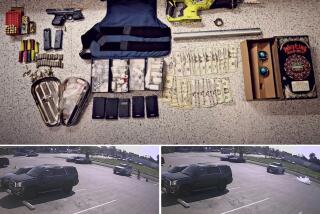Fuzzy Wuzzy Lifesaver : Teddy Bear With Beat Helps Premature Infants Learn to Breathe
STORRS, Conn. — When month-old Vito Colucci snuggles up to the baby-blue teddy bear in his incubator, he’s getting more than creature comfort.
Vito, born 13 weeks premature, also is learning how to breathe.
The hand-sewn, sheepskin bear in the Isolette at the University of Connecticut Health Center in Farmington has a balloon in its abdomen connected to a mechanical air pump so the bear mimics the deep, gentle inhaling and exhaling of a healthy, sleeping person.
A research project under way at the university and St. Francis Hospital and Medical Center in Hartford has shown that the bears can help regulate breathing by inducing deep, quiet sleep in preemies, who frequently suffer respiratory disorders, said Evelyn Thoman, the behaviorist who designed the project.
‘Like Mummy and Daddy’
“This is a stimulation that I call biologically relevant,” Thoman said in a recent interview. “It’s sort of like having a companion to sleep with. It’s breathing, just like mummy and daddy.”
Thoman came up with the idea about 15 years ago and experimented on rat pups deprived of their mothers. Those given a surrogate mother--a warm, moist, pulsating tube--survived. Those without a surrogate died.
Premature infants were a natural subject for the study, since they too are separated from their mothers when they are isolated in an incubator.
It took Thoman years to come up with the design for the bear--commercially made ones have protruding snouts and limbs that keep infants at a distance--and a pump to duplicate the gentle rhythm of human breathing.
Harvard Apparatus Inc. of South Natick, Mass., developed the pump.
After some preliminary work, she got a $500,000 grant from the National Institute of
--------------------------------------------------------------------------
The experiment is based partly on the principle of entrainment, which explains why grandfather clocks on the same wall will eventually synchronize.
--------------------------------------------------------------------------
Child Health and Human Development for a three-year study that runs until May. Thoman and her research assistants monitor how the babies respond to the bears through time-lapse photography.
The experiment is based partly on the physics principle of entrainment, which holds that allpulsating or beating objects, animate and inanimate, tend to match the rhythms of nearby objects.
The phenomenon explains why half a dozen grandfather clocks on the same wall, all beating at different tempos, eventually will synchronize. In people, it means the various body rhythms--sleep patterns, temperature, breathing, heartbeat--influence each other, Thoman said.
Thoman theorizes that the bears may calm colicky babies, and that aside from helping infants learn to breathe the bears stimulate brain development by letting the babies choose when to snuggle up to the toys.
Passive Stimulation
Doctors have known for years that underdeveloped, premature infants, isolated in an incubator away from their mothers and the outside world, need stimulation to thrive. But the stimulation used for years has been passive: The incessant sound of an electrical heart implanted in a stuffed animal, the rising and falling of a breathing air mattress.
The babies in the experiment snuggle with their bears about half the time and move away by themselves the rest of the time.
Thoman’s bears have been mentioned in writings on sudden infant death syndrome, but she cautions that it’s too early to theorize her device will help prevent the mysterious killer of apparently healthy babies.
“We have demonstrated (that) the bear facilitates maturation and that it helps the babies breathe more regularly,” she said. “There is a logical jump to say, ‘Shouldn’t (that) help prevent SIDS?’ And in my wildest dreams, I would hope so. But that’s too far away; there is too much research to be done.”
More to Read
Sign up for Essential California
The most important California stories and recommendations in your inbox every morning.
You may occasionally receive promotional content from the Los Angeles Times.








